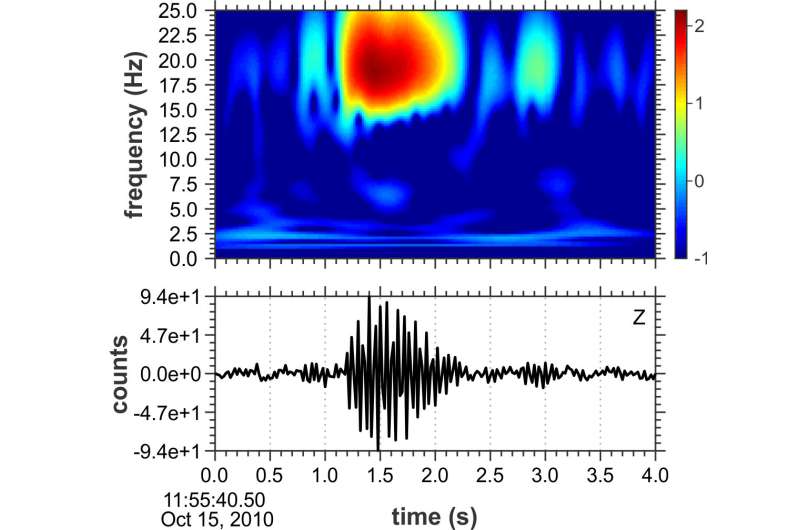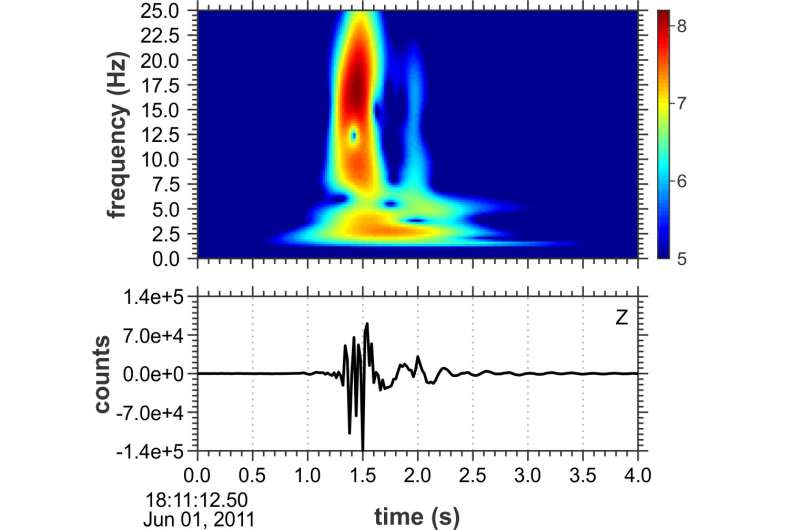Listening for micro-earthquakes, hearing mega-whales in the Arctic

How does the sound of a tiny Earth tremor differ from the sound of a huge passing whale? That is one of the things that scientists had to figure out while listening for the sound of methane release from the sea floor.
A recent study in Geochemistry, Geophysics and Geosystems strongly links methane leaks from the seabed off Western Svalbard with tremors of the Earth.
"We can't say if the micro-earthquakes or other micro seismic events are causing the methane leaks or if it is the other way around. A possible explanation is that the build-up of methane below the ocean floor creates bubbles. They could cause very weak tremors as they migrate, expand and release gas into the water column in the area." says Peter Franek first author of the study, and researcher at CAGE Centre for Arctic Gas Hydrate, Environment and Climate.
The study area is a host to hundreds if not thousands of known methane leaks. They are associated with temporal changes in dissociation of gas hydrates –the icy substance that contains huge amounts of methane. This causes methane release from the seafloor, and potentially into the atmosphere.
Unique study
The tremors described in this particular study are called short duration events, and are definitely not caused by the same mechanisms as proper earthquakes. Short duration events are only detectable due to a novel use of highly sensitive listening devices.

"This study is unique because we are using instrumentation and techniques commonly used for earthquake research. We use them to identify tiny earth movements generated by the circulation and release of gas from the seafloor. Very few in the world are working with this approach at such a scale." says researcher and co-author Andreia Plaza Faverola at CAGE.
The underwater world is full of different natural sounds that can be recorded by cutting-edge underwater technology such as ocean bottom seismometers (OBS), that include hydro– and geophones. An OBS was placed at the ocean floor at 400-meter water depth offshore Western Svalbard, and recorded every sound from the seabed and ocean for a full year. It was then retrieved by the research vessel Helmer Hanssen from UiT The Arctic University of Norway.
Whale calls – an interesting interference
All sounds within a given frequency range were recorded for this study. Scientists then needed to differentiate between the sounds of methane associated tremors and other recurrent sounds.
"It turns out that fin whales are abundant offshore Western Svalbard and communicate with each other within the range of our investigation. It was an added pleasure for us to record their activity as well as the activity of the methane seeps themselves." says co-author of the study professor, Jürgen Mienert at CAGE.
Fin whales are some of the largest animals in the world, only surpassed in size by the blue whale. Peter Franek says that the scientists clearly were able to make out the calls of the fin whales to such detail that it might be useful even to the biologists who wish to study movement and sound communication patterns of these majestic animals.
"OBS is a non-invasive tool primarily designed for recording natural, non- biological or man-made seismic and acoustic signals. Unexpectedly, it can be used to study communication between whales. It can give a more detailed insight on call patterns, respiration times and swimming speeds of fin whales in their natural habitat, without disturbing them with any human presence."
More information: Peter Franek et al. Microseismicity Linked to Gas Migration and Leakage on the Western Svalbard Shelf, Geochemistry, Geophysics, Geosystems (2017). DOI: 10.1002/2017GC007107
Journal information: Geochemistry, Geophysics and Geosystems
Provided by University of Tromsø




















